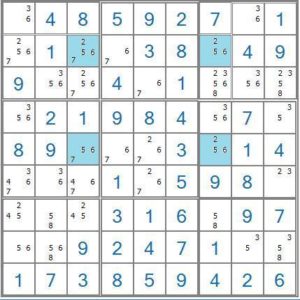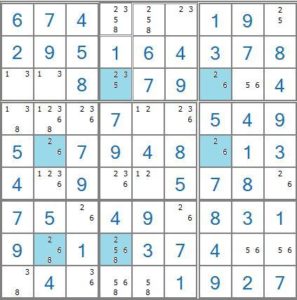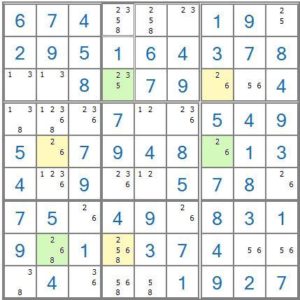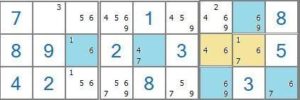
Sudoku Complex Strategies – The X-wing Technique
Let’s now look at some of the more complex strategies individually. Let’s start with one of the more well known advanced strategies, X-Wing. Take a look at the board below, which is set up to demonstrate this technique.

You’ll often see patterns like these on the more difficult game boards, and they’re always arranged in a similar fashion, though they may be spaced much farther apart. The key is that they are aligned along the same rows and columns.
This strategy can be deployed when you see this setup, with one number occupying each of the 4 cells, and when that number MUST occupy 2 of those 4 cells (in this case we have 2 numbers appearing in all 4 cells, but only the 5’s actually qualify for the X-Wing treatment).
So how do we identify this pattern? Well we can see on rows 2 and 5 that the 5 must reside in one of the 2 cells in the pattern (unlike the 6, which is not an X-Wing candidate because it can still reside elsewhere on both rows and columns still).
Since we now know that a 5 must reside in each of those columns in one of the two specified cells, we can remove them as candidates from the other cells in those columns.
This is a great help to us in R7C7, where we’ve now unlocked the 8 as the big number and broken this puzzle open. Without identifying the X-Wing pattern there, this puzzle would have been much more difficult to figure out.
The name X-Wing comes from the fact that we know the number(s) in question must finish diagonally across from each other, since in each position there is a row or column connected to it. So the two possible positions the numbers could end up in makes an X shape between the cells. Look for this pattern when you’re stumped on a puzzle.
Swordfish Technique
Next we move onto Swordfish, a technique in the same vein as X-Wing, only this time we’re looking at 3 columns and 3 rows, instead of X-Wing’s 2.
Check out a sample scenario below.

Swordfish is a little trickier to spot than X-Wing for 2 reasons; firstly is the simple fact that the pattern is larger, with more cells involved. But perhaps even more so is the fact that Swordfish has no definable pattern like X-Wing. Since we’re dealing with 3 cells and 3 rows, there’s no forced box-like pattern like a 2 X 2 pattern forces.
The main points to remember are that 3 rows or columns have to contain 2 cells that the number in question MUST go in, and that these 3 rows or columns must be connected to each other (the rows must align with the columns or vice versa). This creates what is called a forced loop. An X-Wing is also a forced loop, just a shorter one.
So take a look at our example. We can see that on rows 3, 5, and 8, we have 2 possible cells on each row that could contain the number 2. Also note how these three rows are connected along 3 different columns, which is what creates that closed loop. To see how this technique unfolds, take a look at the next image.

This shows us the only two possible layouts the 2’s could finish in. Either they’ll all finish in the green cells, or they’ll all finish in the yellow cells. As you can see, in addition to there being a 2 in one of the cells in each of the 3 rows (which we already knew, since that’s what started the Swordfish technique in motion), we now know that a 2 will also reside in one of those 2 cells in each column as well. This helps us out immensely, as we can now eliminate the 2 as a candidate from several cells in those 3 columns.
While Swordfish can be difficult to spot, it’s all but necessary to complete difficult Sudoku puzzles. Remember to keep an eye out for places where you can use this technique to bust out of tough spots. In addition to Swordfish, this technique goes even deeper with a 4 row/column version called Jellyfish. This technique is rarely found or needed in puzzles, but if you’re stumped and looking for answers, remember that it functions in the same way as X-Wing and Swordfish.
The only notable difference is that up to 4 cells can be occupied on each row/column, as opposed to 2. Once spotted, the process of deduction is the same, allowing you to remove the candidates from the connected rows/columns.
Aligned Pair Exclusion
Next up is a neat little technique called Aligned Pair Exclusion. Take a look at our partial game board below.

For now take a look at the two cream-colored cells at R2C7 and R2C8.
These cells are the focal point of this technique, as we’ll be trying to figure out which combination of numbers is possible in those two cells.
As of right now, the possible combinations are 1-4, 1-6, 4-6, 4-7, and 6-7.
Now check out the cells in blue. These cells are either in the same box or along the same line as the cells we’re trying to figure out, and only contain 2 candidates each.
This means that no matter what, our two cream-colored cells cannot contain the same combination of numbers as any of these cells, since that would leave those cells without a candidate.
So out of our 5 previously possible combinations, 3 of them get wiped out, 1-6, 4-7, and 6-7, which are contained in cells connected to these 2 cells.
That leaves the only possible combinations as 1-4, and 4-6. So we now know that R2C7 must be a 4, since 4 has to be in our combination, and R2C8 does not have a 4.
We can also wipe the 7 out as a candidate in R2C8.
When you get down to the end of a difficult puzzle and find you have a lot of cells with just 2 possible combinations, this technique will prove to be extremely handy.
Just remember that only cells with 2 candidates left, and which are connected to both of the cells you’re targeting (so it can only be cells either along the column or row, whichever is applicable, but not both, as well as the box), can be used to uncover those cells.
How To Play Sudoku Part 6 – Alternative Strategies and Sudoku Variations

Be the first to comment